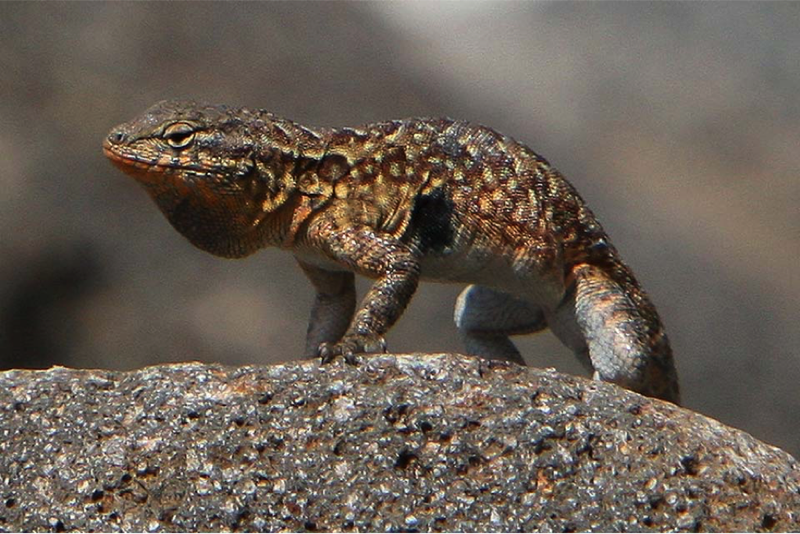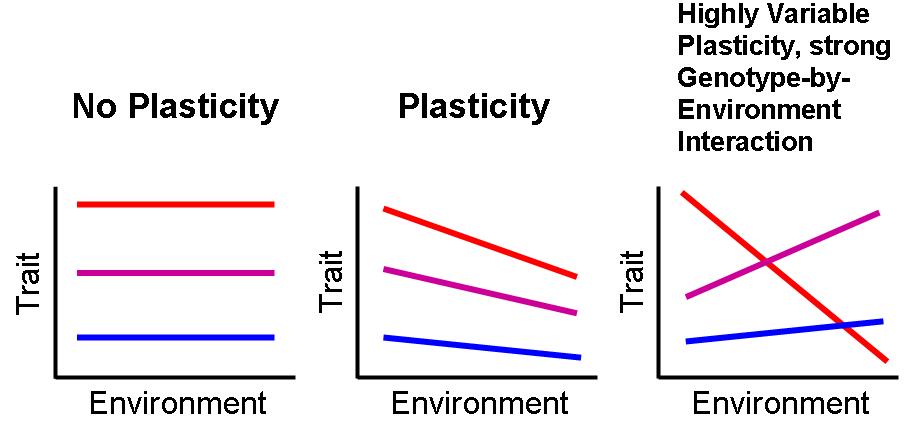Phenotypic plasticity is the ability of a genotype to produce varied phenotypes depending on the underlying environmental conditions faced during the organism’s development. A population’s inability to rapidly adapt to abrupt and significant variation in environmental conditions, often leads to their extinction. In such scenarios, the ability of an individuals to express different phenotypes, with a fixed genotype, allows individuals to tolerate and rapidly adapt to changing environmental conditions (DeWitt et al., 1998). For this reason, phenotypic plasticity has played a crucial role in evolution. In fact, human disturbances may be causing the evolution of spcies by invoking phenotypic plasticity.
The evolution of phenotypic plasticity significantly diminishes the risk extinction of various species. This is particularly the case with passerines and reptiles. For example, it is estimated that plasticity, particularly in metabolic rates and water loss rates, reduces risk of extinction associated with climate change by 72% in red cheeked salamanders (Plethodon jordani) (Riddell et al., 2018)
As such, plasticity is more prominent in predictable environments than in unpredictable environments (Leung et al., 2020). This can be attributed to the predictive adaptive response. This is when, in response to perceived future environmental conditions, the development trajectory of an organism is established during the rudimentary development stages. While the benefits of the predictive adaptive response are not immediate, if the postnatal environment is accurately predicted, the organism’s fitness will significantly increase (Leung et al., 2020). Therefore, plasticity provides mechanisms to cope with temporal and spatial variance, hence improving their fitness in heterogenous environments (Levis et al., 2016).
So how does Phenotypic Plasticity promote Evolution?
By increasing adaptivity, plasticity facilitates rapid adaptation, and hence evolution, to stressful environments (Levis et al., 2016). Furthermore, plasticity generally precedes adaptations to new environments. For example, colour plasticity was observed in Side Blotched lizards (Uta stansburiana) living on and living off lava, before the relevant genetic divergence occured. Populations which colonized lava were darker and possessed variants of melanin regulators PREP and PRKAR1A genes, which were associated with increased pigmentation. According to stimulations, the selections of these variations occurred significantly after the colonization of lava and the origins of darker pigmentations (Corl et al., 2018).

The occurrence of plasticity provides temporary adaptations to newer environments while the respective genetic variations are established in the population. Genetic variations then provide these populations with heritable phenotypes suited to the evolving selection pressures (Ghalambor et al., 2007). Furthermore, an environmentally induced change in morphology is often followed by physiological and behavioural alterations. For this reason, plasticity in one trait could indirectly influence the evolution of numerous interlinked traits, further catalysing evolution (Price et al., 2003).
The immediate nature of plastic responses, therefore, does promote population divergence. In fact, as population divergence is often associated with speciation, plasticity may have a crucial role in the latter process as well. Furthermore, the intraspecific phenotypic variation produced by plasticity is often analogous to the interspecific variation observed between members of the same clade (West-Eberhard, 2005).
Genetic Accommodation and Assimilation
Phenotypic plasticity further contributes to diversification through genetic accommodation and assimilation (Price et al., 2003). Genetic accommodation is the evolutionary mechanism where an environmental induced phenotype is enhanced into an adaptive phenotype through quantitative genetic changes (Price et al., 2003). This often leads to alterations in the sensitivity of plastic phenotypes towards environmental conditions. Genetic assimilation occurs when plastic phenotypes lose their environmental responsiveness and, in the process, becomes a constitutively expressed trait. Significant intraspecific genetic variation occurs as plastic phenotypes become heritable through genetic assimilation (Price et al., 2003).Additionally, genetic accommodation potentially catalyses polyphenism, which is when individuals sharing identical genomes have varied responses to the same environmental stimulus. This results in distinctly different adaptive phenotypes (Price et al., 2003).
Phenotypic Plasticity can sometimes prevent Evolution!
Nonetheless, there have been arguments against the idea that plasticity facilitates evolution for two primary reasons, Firstly, through plasticity, a single genotype is able to produce numerous phenotypes to cope with different environmental pressures. This removes the requirement of genetic alternatives for obtaining a fitness optimum (Pfennig et al., 2010). Secondly, through plastic responses different genotypes can produce the same phenotype. This masks the differences between genotypes, allowing them to escape selection (Pfennig et al., 2010).

It has been theorized that there are three factors which influence whether plasticity impede or facilitate evolution (Pfennig et al., 2010). The first factor is the degree to which plasticity is expressed within a population (Pfennig et al., 2010). Moderate levels of plasticity promote diversification by encouraging population survival in novel environments, while also moving populations towards the attraction realm of adaptive peaks (Price et al., 2003). Low levels of plasticity do neither (Price et al., 2003). Meanwhile, high levels of plasticity do increase the chances of population survival. However, it propels populations towards an adaptive peak, which diminishes, both the effects and the probability, of the selection of genetic variations. This, therefore, inhibits diversification (Price et al., 2003).
Phenotypic Plasticity influences gene flow!
The impact of plasticity on gene flow is another factor influencing the ability of plasticity to facilitate evolution (Pfennig et al., 2010). Plasticity allows dispersing organism to adapt to the alternate environmental conditions of the habitat they migrate through. This encourages gene flow between certain environments, which influences adaptive divergence between populations (West-Eberhard, 2005). For this reason species, such as the Nawab Butterflies, undergoing climate change induced migration, may experience greater evolution. The last factor is the genetic correlation between the trait and the degree of plasticity (Pfennig et al., 2010). The evolution of the trait will be inhibited when strong genetic correlations occur. Meanwhile, weak correlations will slow the trait evolution (Pfennig et al., 2010).
Plasticity can also be Maladaptive!
It must be noted that plasticity can also be maladaptive. Through the predictive adaptive response, there is a fairly high risk of phenotypic and environmental mismatch. In such scenarios, plastic responses will not be suitable for the postnatal environment. The risk of such mismatches is exacerbated in unpredictable environments. This is simply because of the challenges of predicting postnatal conditions (Leung et al., 2020).
Examples of Maladaptive Plasticity
A prominent example of this phenomena can be observed in hermaphroditic nematode Caenorhabditis elegans. When exposed to predictable fluctuations in anoxic and normic conditions, populations displayed plasticity in maternal glycogen production in alternating generations. Such plasticity was not observed in populations exposed to irregularly fluctuating oxygen conditions. Instead, the evolution of long-term transgenerational effects was observed in such populations (Dey et al., 2016). Similarly, reduced morphological plasticity was observed in Dunaliella salina when exposed to randomly fluctuating salinity conditions than systematically fluctuating conditions (Leung et al., 2020).
What triggers maladaptive plasticity and how does it influence evolution?
Unreliable environmental signals, also promotes plasticity maladaptiveness (DeWitt et al., 1998). For example, phenotypic plasticity can be either adaptive or maladaptive in freshwater snails (Physa virgata) due to unreliable signalling. When exposed to a predator, the bluegill sunfish (Lepomis macrochirus), the snails make their shells more rotund and crush resistant. This provides protections against predation (DeWitt et al., 1998). However, the snails lack the ability to discriminate between predatory and non-predatory sunfish species. This results in the snails displaying the antipredator phenotype, even in response to the latter group. The results in reduced growth and altered shell morphology (DeWitt et al., 1998).
Nonetheless, maladaptive plasticity can also promote evolution (Schmid and Guillaume, 2017). As such, adaptive plasticity which produces phenotypic divergence regardless of high gene flow. Compartively, maladaptive plasticity promote evolution through the restriction of the effective gene flow. This causes high genetic compensation and counter gradient phenotypic variation in the opposite direction of environmental changes (Schmid and Guillaume, 2017).
To conclude, while plasticity can be both, adaptive and maladaptive, its role in evolution cannot be understated. Not only does plasticity allow populations to produce phenotypes suited to the rapidly changing environments, it also provides the genetic mechanisms for such adaptation, hence promoting evolution.
Help us Help Them! Think Wildlife Foundation is a non profit organization with various conservation initiatives. Our most prominent campaign is our Caring for Pari intiative. Pari is a rehabilitated elephant at the Wildlife SoS Hospital. 25% of the profits from our store are donated to the elephant hospital for Pari. Other than buying our wonderful merchandise, you could donate directly to our Caring For Pari fundraiser.
